I look down through the cracks on the rotten planks of wood and see the murky green water below. Most people would seek high ground when considering a suitable place to build their homes, but not the clans who have settled along Georgetown’s waterfront.
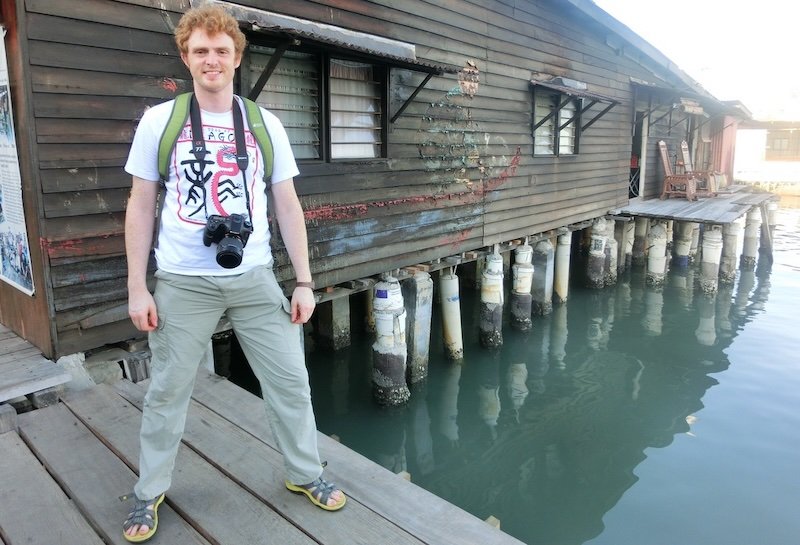

The Weld Quay Clan Jetties have been in existence for over 100 years, and are home to small communities who built their homes on stilts above the water. The people who settled the jetties were Chinese migrants who came to the bustling port city of Georgetown, Penang seeking better opportunities.
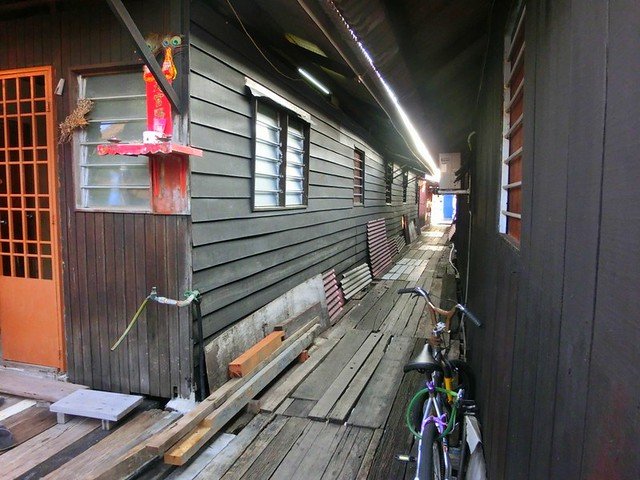
Entire families moved out here and the various clans grouped together according to their province of origin, leading to the creation of several jetties along the water’s edge.
Today there are six jetties; the five main clans being Lim, Chew, Tan, Lee and Yeoh, while the remaining jetty, Chap Seh Keo, is home to a mixture of families who do not share the same name.

What surprised me most about my visit to the jetties was that life goes on very much the same way it would on dry land. People ride their bicycles and even motorbikes down the planks of wood which act as roads and sidewalks.
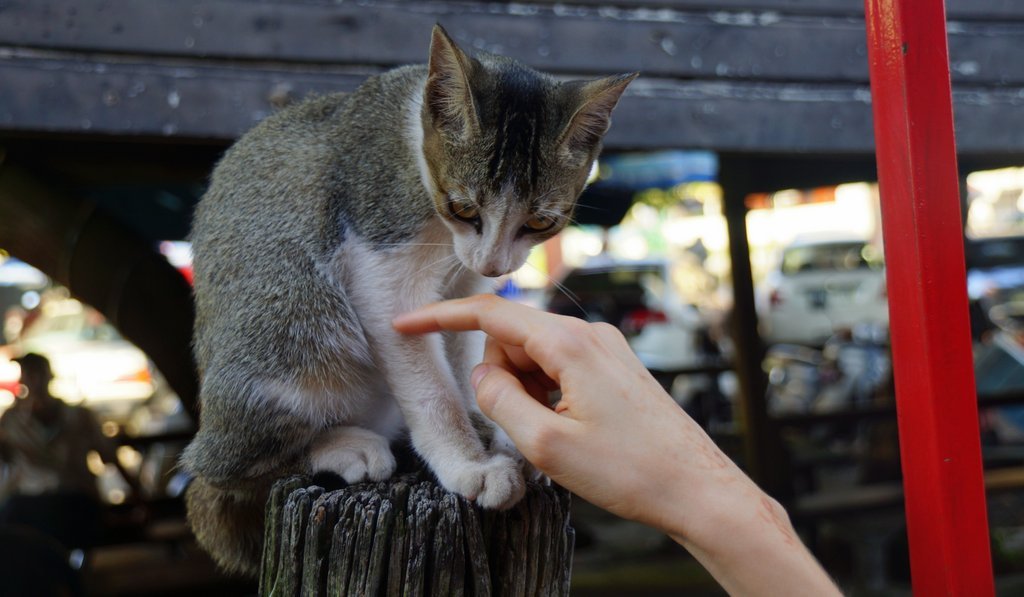
Dogs nap in the shade and come to play when they see a friendly foreigner come their way, old men sit on their porches and watch the day go by without a care in the world, and a curious kitten balances itself on a wooden post not too far from the water’s edge.

These aren’t just homes. This is a thriving community with temples, restaurants, and stores, offering everything you might need on a daily basis. Many of the homes have also upgraded their amenities over time, and you can even see satellite dishes mounted on top of the metal sheet roofs.

There isn’t one particular attraction to visit at the jetties, but if you want to wander around a unique community and see how life goes on above the sea, then this is the perfect place to do so.
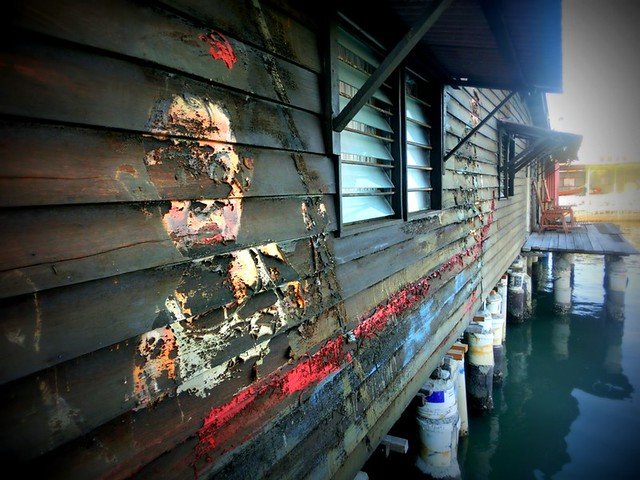
And lastly here is a little video tour of our afternoon exploring the Weld Quay Clan Jetties, and of course I found cute puppies and kittens:
Plan Your Visit to the Clan Jetties (Routes, Etiquette, Photo Tips, Food & Handy Checklists)

How to Get There
Georgetown’s Clan Jetties line Weld Quay (Pengkalan Weld) on the eastern edge of the UNESCO core, so reaching them is straightforward.
Your options:
- On foot: From Armenian Street/Street Art area it’s a pleasant 10–15 minute walk. Follow signage for Chew Jetty (the most visitor-friendly jetty).
- Bicycle: George Town is flat and bike-friendly. Lock up near the entrances; boardwalks are pedestrian-first (walk bikes if it’s busy).
- Ride-hail (Grab): Drop-off at the small parking area in front of Chew Jetty. Handy if you’re hopping between sights in the heat.
- Bus: Rapid Penang services run along Weld Quay. Tell the driver you’re going to the Clan Jetties and hop off where the jetty signboards begin.
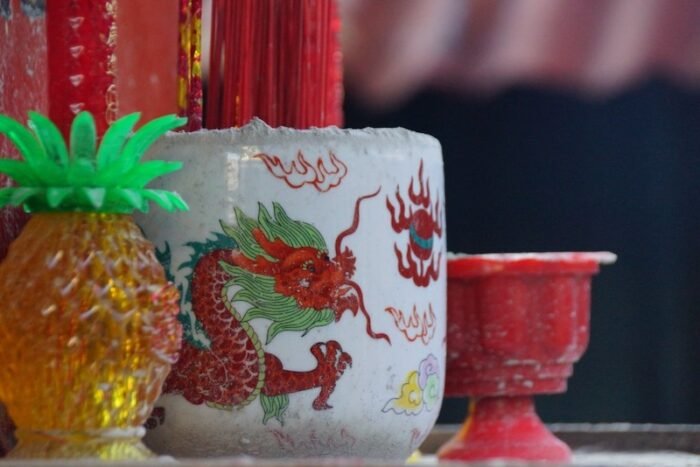
A Quick Orientation: What’s Where?
There are six jetties today—five clan-based (Lim, Chew, Tan, Lee, Yeoh) and one mixed (Chap Seh Keo). You’ll find Chew Jetty is often the most open to visitors, with small cafes, souvenir stalls, and some homestays at the far end. Others feel more residential and may display “private” signs—follow them.
At-a-Glance Jetty Comparison
| Jetty | Vibe for Visitors | Typical Highlights | Etiquette Notes |
|---|---|---|---|
| Chew | Most visitor-friendly | Boardwalk to the water, little shops, homestays, lanterns | Respect private side lanes; keep voices low |
| Lim | Quieter, residential | Shrines, laundry lines like bunting, daily life scenes | Follow “No Entry/Private” signs |
| Tan | Local pulse | Small altars, sea views, fishermen’s gear | Step aside for residents/carts |
| Lee | Cozy lanes | Timber textures, sea breezes, old doors | Ask before photographing people |
| Yeoh | Peaceful and lived-in | Temples, potted plants, cats with attitude | Avoid blocking doorways |
| Chap Seh Keo | Mixed families | Patchwork of homes, boats, daily chores | Keep to the main boardwalks |
2 Easy Walking Routes (Pick One…or Do Both)
Route A: “First-Timers’ Golden Hour” (60–90 minutes)
- Start: Chew Jetty entrance (lanterns, first boardwalk).
- Stroll: Walk the full length slowly; peek down side lanes only where there’s no “Private” signage.
- Pause: At the end where the boardwalk opens to the water. Watch boats, tides, and Penang Strait light shifts.
- Snack: Grab a cold drink or iced coffee near the entrance and people-watch from the shade.
- Optional: Pop into a small shrine if open; leave a small donation.
Best for: Easy access, first-time photos, relaxed pace.
Route B: “Jetty Hop & Heritage” (2–3 hours)
- Start: Lim Jetty for quiet morning scenes.
- Continue: Chew Jetty for a longer linger and sea-end views.
- Hop: Walk along Weld Quay to Yeoh/Tan/Lee for shorter looks (respect private signs).
- Add-On: Wander back towards Street Art lanes or Khoo Kongsi for a heritage fix.
Best for: Slow travelers, photographers, anyone chasing textures and stories.
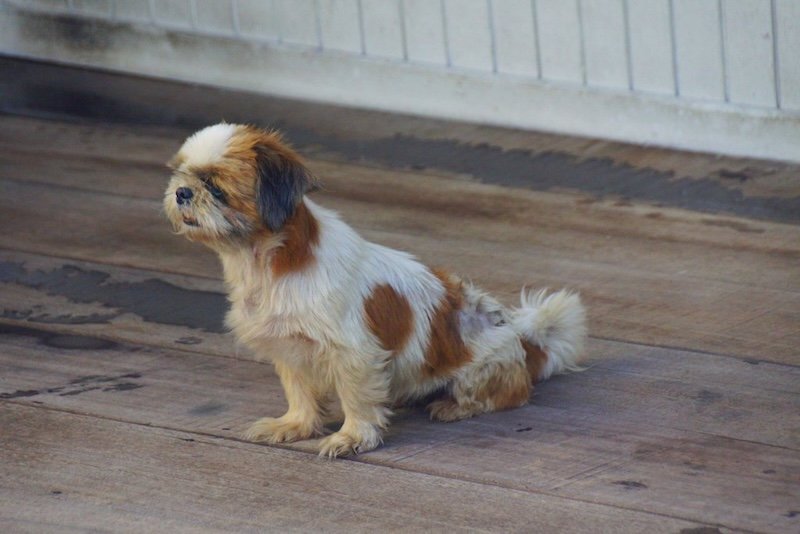
Respectful Etiquette Whilst Visiting
- Keep voices low. Sound carries over water and wooden planks.
- Walk, don’t ride, if it’s busy. Park bikes at the entrance.
- Private signs = private. Even if the light is dreamy—don’t enter.
- Ask before portraits. A smile + gesture to your camera goes a long way.
- No drones unless you’ve secured proper permission.
- Do not litter. Sea communities feel trash immediately. Pack it out.
- Support locally. A cool drink, snack, or small souvenir keeps small businesses afloat (literally).
Photo Ideas: Shots You’ll Love (and How to Get Them)
Golden, Blue & Lantern Hours
- Golden hour: Aim down the boardwalk with backlit lanterns and long shadows.
- Blue hour: After sunset, the sky turns cobalt; capture lantern glow reflecting on weathered planks.
- Overcast days: Dreamy for pastel tones and soft portraits without squinting.
Angles That Sing
- Boardwalk leading lines: Place the vanishing point at the horizon for a timeless “living-above-the-sea” feel.
- Doors & windows: Focus on color, patina, and textures (paint chips, rusted hinges, hand-lettered house numbers).
- Hands at work: Fishing nets, broom sweeping, tea pouring—ask, smile, shoot.
Quick Settings (Phone/Cam)
- Phone: Turn on grid; tap to expose for highlights; use HDR sparingly to keep it natural.
- Camera: Start f/4–f/5.6, ISO 100–400, adjust shutter to taste; for blue hour, stabilize on a railing or pack a mini tripod.
- Polarizer: Handy around water for glare control and richer sky.
What to Eat & Drink (Close to the Boardwalks)
- Cool-down drinks: Fresh lime juice, iced coffee, longan tea, coconut water. A lifesaver after the sun hits.
- Local snacks: Peanut pancakes, kaya toast, fish balls, curry puffs—simple and satisfying.
- Nearby hawker centers: Along Weld Quay and deeper into the UNESCO core, look for char koay teow, Hokkien mee, asam laksa, cendol. If it’s packed with locals, you’ve picked well.
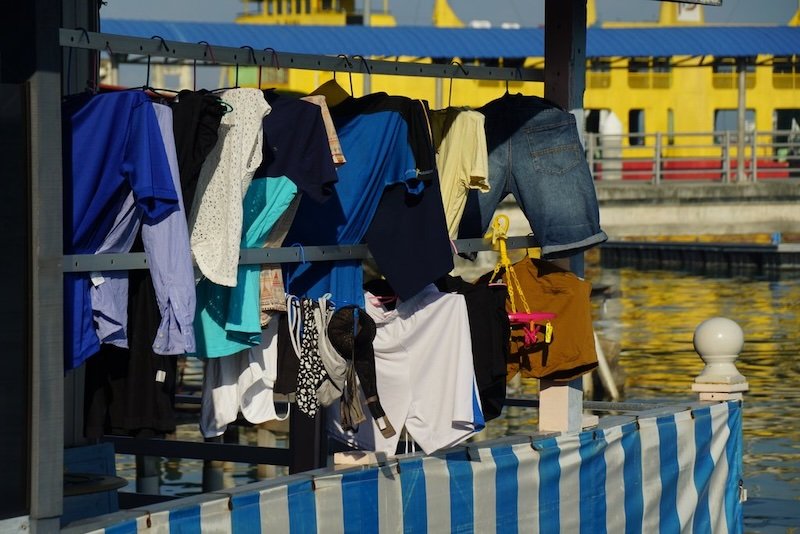
Safety & Comfort (Because Splinters Happen)
- Footwear: Closed-toe shoes or sturdy sandals with grip. Avoid heels—gaps in planks are sneaky.
- Sun armor: Hat, SPF, sunglasses; the heat reflects off water and wood.
- Weather: Sudden showers happen. Carry a light rain jacket or scarf.
- Hands free: Keep one hand ready to steady yourself on railings.
What to Bring: Jetty-Day Checklist
Essentials
- ☐ Water bottle (refillable)
- ☐ Sunblock + hat + sunglasses
- ☐ Cash (small notes for snacks/donations)
- ☐ Hand sanitizer + tissues
Nice-to-Haves
- ☐ Mini tripod or phone stand
- ☐ Light rain layer
- ☐ Portable fan (game-changer in the afternoon)
- ☐ Reusable tote for small purchases
Photo Kit (Keep It Minimal)
- ☐ One versatile lens (24–70mm or prime)
- ☐ Extra battery / phone power bank
- ☐ Microfiber cloth (humidity + sea spray)

Budget Snapshot (Per Person)
- Entry: Free (donations welcome at shrines).
- Drinks/snacks: RM 3–12 (USD ~0.60–2.50).
- Souvenirs: RM 5–30 depending on item.
- Transport: Grab within UNESCO core is usually inexpensive; walking is still the best way to meet friendly cats.
Jetty Etiquette vs. Street Art Etiquette (A Quick Table)
| Situation | Jetty | Street Art Lanes |
|---|---|---|
| Noise level | Low, calm | Lively is okay |
| Space | Narrow boardwalks | Wider alleys |
| Locals’ privacy | High priority (homes) | Moderate (shops/cafes) |
| Best time | Early/late | Early before crowds |
| Tripods | Discreet only | Easier if off to the side |
Pair Your Jetty Visit with These Nearby Sights
- Armenian Street & Street Art (mural wandering + cafes)
- Khoo Kongsi (jaw-dropping clan house)
- Pinang Peranakan Mansion (heritage interiors)
- Fort Cornwallis & Esplanade (sea breezes, evening strolls)
You can comfortably do Chew Jetty + Armenian Street + Khoo Kongsi as a half-day saunter with plenty of snack breaks (as it should be).
A Slow, Satisfying Mini-Itinerary
- 8:00 a.m. Chew Jetty entrance: iced coffee for the walk.
- 8:10 a.m. Boardwalk wander: doors, steps, cats, lanterns.
- 8:40 a.m. Sit at the far end; watch boats drift past.
- 9:00 a.m. Loop back slowly; pause for a shrine and a snack.
- 9:30 a.m. Stroll to Khoo Kongsi or Armenian Street (street art + brunch).
- 11:30 a.m. Hawker lunch (asam laksa or char koay teow). Treat yourself to cendol—you earned it.
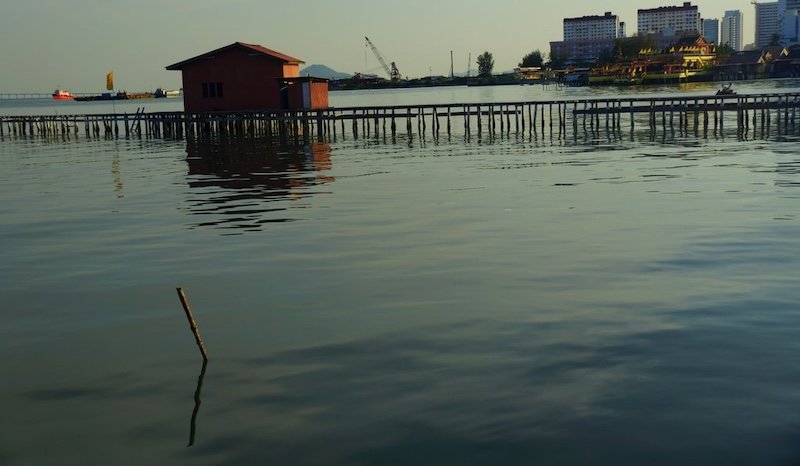
FAQ: Clan Jetties Visitor Questions (Answered)
How long should I plan for the jetties?
60–90 minutes for Chew Jetty alone; 2–3 hours if you’re jetty-hopping and photographing slowly.
Is there an entrance fee?
No. Entry is free, but consider small donations at shrines and supporting local stalls.
Which jetty is best for first-time visitors?
Chew Jetty—clear signage, wider boardwalk, and easy sea-end views. Start there and add others if you have time.
Can I bring kids?
Yes! Kids tend to love the boardwalk adventure. Keep little hands close—there are gaps in the planks.
What should I wear?
Light, modest clothing for the heat; closed-toe shoes with grip; a hat. Bring a light layer for sudden showers.
Are photos allowed?
Generally, yes—landscapes and textures are fine. For people or private spaces, ask first. Avoid flash inside small shrines.
When’s the best time for photos?
Early morning for calm and soft light; late afternoon to sunset for golden tones and lantern glow.
Can I fly a drone?
Not at the jetties without explicit permission. It’s a residential zone with narrow lanes and many overhead lines.
Is it okay to bike on the jetties?
Roll to the entrance, then walk your bike on the planks—especially when busy. Safety first.
What if it rains?
Tropical showers come and go. Boardwalks can get slick; take smaller steps and wait showers out under awnings.
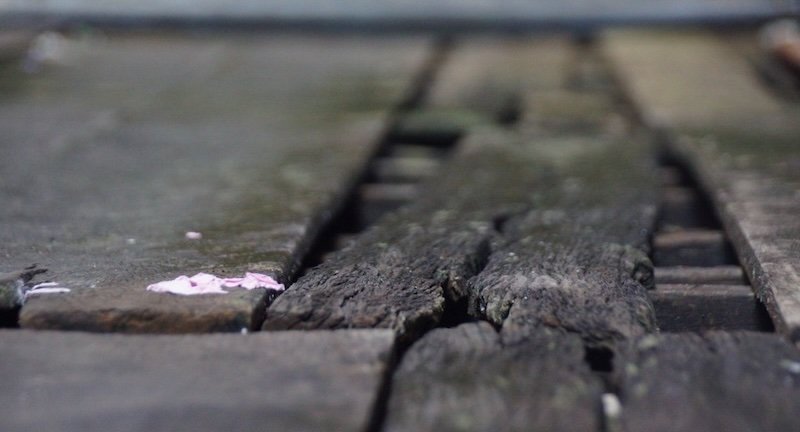
Are there bathrooms?
Facilities are limited and primarily for residents. Plan a restroom stop before or after your visit at nearby cafes.
What else should I combine with my visit?
Pair with Armenian Street, Khoo Kongsi, or a hawker center lunch. If you’re chasing sea views, stroll the Esplanade afterward.
For more info on travel in the country, you can check out my 1-month Malaysia travel itinerary.
Have you ever visited a community that lives above the sea?

Your pictures are amazing! Takes me back there 🙂 I have been to Georgetown and I didn’t know that background story.
Thanks Zhu! I almost missed out on this place – it’s not listed in many guidebooks, but it’s so worth exploring!
Interesting! I love the video 🙂
Thanks Rika! Glad you enjoyed the video. 🙂
What a cool place! That’s so interesting that they just created their own land and live normally on those planks. It looks like a pretty intimate community… did they seem to mind you guys wandering around? Or were they pretty welcome to tourists? Thanks for sharing the video! 😀
They didn’t really seem to mind tourists, but then again, there weren’t that many of us around. We just tried to be discreet and not get in anyone’s way with our filming. 🙂
Wow, these are so interesting! I don’t think I’ve ever seen anything like this before.
Had never heard about the Clan Jetties before.
Thanks for the introduction:)
Lovely pictures, as always. You really captured the place. Takes me right back.
Great photos, the place looks amazing. It is on my Travel Bucket List.
Wow, really interesting. Though I can’t say I’d live there – I have a horrible fear of water!
Hi Audrey, I’m newish to your blog and love it.
Have you been to Panyee Village in Phang Nga, Thailand? It looks very similar. It’s built around a tiny island, so small in fact that basically the mosque and the cemetery are built on the land but everything else is built on stilts over the water. Most of the people living there fish for a living or take tourists on tours of the nearby caves. It’s fascinating to see the way the people live.
Hi Karyn, happy to hear you’re enjoying the blog. 🙂 I actually haven’t been to the Panyee Village but it sounds like the kind of place I’d enjoy visiting. If I ever swing through Phang Nga I’ll make time for that.
This place was really neat!
If you wish to know more about the history about this place, you may log on to http://www.mychewjetty.com
The uniqueness of this place is still preserved- everyone is still Chew. Most of us are related no matter far or closed knit. Lots of people thought the residents are fishermen but they are not. Most of them used to be transporter on the sea.
It’s our great pleasure to be born and grown up here. The living experience here totally different. We used to swim in the sea, slept at the five foot way, squatted and ate rojak from the local petty traders, … Can you imagine Hokkien Mee is delivered to your door step?
Welcome to Jetties!